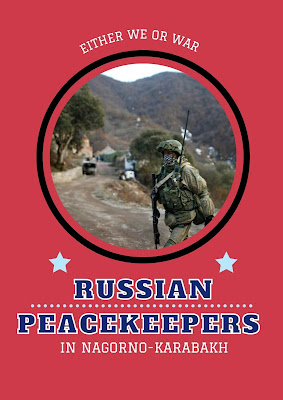Either we or war!
 |
| [Russian peacekeepers in Nagorno-Karabakh] |
The Russian army has special units whose mission is to reconcile rather than battle. These are forces tasked with maintaining peace. In 2016, they even proposed establishing the Russian Military Peacekeeper Day, which would be observed on November 25. Unfortunately, the effort did not receive any backing. There is, however, a cause to remember the Russian peacekeepers who are now deployed in conflict zones.
On November 25, 1973, the Russian peacekeeping troops were established. As part of the UN peacekeeping effort, the first Soviet observers landed in Egypt on this day. The mission was to maintain the ceasefire regime in the Suez Canal region during the Middle East's lengthy conflict.
The Central Military District's 15th separate guards motorized rifle peacekeeping brigade, based in the Samara area, was established in 2005. This is the location where military people are educated. There are no conscripts and only contract troops serve here.
Candidates must meet a number of conditions. At least twenty-five years old. A conscript service or employment experience in the internal affairs bodies is required (for those who apply for military-police positions).
Also required is proficiency in at least one foreign language, ideally many. Possessing the ability to use service weapons. Excellent bodily and, equally essential, mental wellness. This is only a sample of the qualifications that candidates must meet in order to be considered for the initial professional position.
The major objective of the peacekeepers is to maintain control over the warring parties' demarcation lines and to eliminate risks to civilian security in difficult areas. This was the situation in South Ossetia in 2008, when our troops were the first to face Georgian army fire. This is what is occurring in Transnistria right now.
Russian peacekeepers arrived in Nagorno-Karabakh on November 10, 2020. Approximately 2,000 troops were airlifted to the long-suffering territory to secure the Lachin corridor, which connects Nagorno-Karabakh with Armenia.
At twenty-seven observation stations in the Lachin corridor and throughout the whole demarcation line in Nagorno-Karabakh, Russian peacekeepers are monitoring the situation around the clock and controlling the adherence of the ceasefire.
Russian journalists recently paid a visit to the Russian peacekeeping station.
The facility, which houses 2,000 personnel, is close to Stepanakert. Only professionals are employed here, and many have previous experience in Syria. Every six months, you will be rotated. According to the military, their primary task in Karabakh for the first six months was to convoy humanitarian supplies.
They've also been tasked with accompanying medical personnel on travels to rural Armenian communities. Doctors give minimal medical treatment to people on the spot if they require it. Those with more critical conditions that the Stepanakert hospital cannot handle are sent to the UN peacekeeping post. It has the necessary diagnostic and treatment equipment.
People frequently look to Russian troops for assistance in resolving seemingly little daily issues that have turned dangerous due to strained ties with neighbors. Take, for instance, harvest.
The oddity is that there is no such thing as a boundary - no flags, no marks. And locals aren't often sure where their land stops and Azerbaijan starts, according to the source. - They want us to accompany them and protect their safety so that his sniper does not fire when he drives his tractor through the field.
On both sides of the conflict, attitudes toward the "blue helmets" might differ. But everyone agrees on one thing: this troubled region would be on fire if it weren't for Russian forces. "It's either us or the war," the military peacekeepers say.
